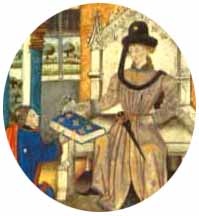| Please note that these pages are from our old (pre-2010) website; the presentation of these pages may now appear outdated and may not always comply with current accessibility guidelines. |
| Please note that these pages are from our old (pre-2010) website; the presentation of these pages may now appear outdated and may not always comply with current accessibility guidelines. |

| The anonymous Speculum humanae salvationis, or 'Mirror of man's salvation', was written in the early years of the fourteenth century. A popular theological work, it survives in some 350 manuscripts, many of which are illustrated. Our copy was produced in Bruges in 1455. This French translation is a de-luxe manuscript on vellum written in a Burgundian bastard script; it is beautifully illustrated with forty two illuminated panels, all executed with exquisite care. |
| The frontispiece displayed here represents the author
of this translation presenting it to his patron,
possibly Philip the Good, the Duke of Burgundy, who is seated on a white
marble throne. A subtle blend of naturalism and symbolism, the patron
and the translator are fashionably dressed and placed in an elaborate
architectural setting. They are accompanied by two female figures beyond
the pillars of the throne room who represent the Church (in the
guise of a nun holding a patriarchal cross and the Chalice and Host),
and the discredited Synagogue (with broken lance and her crown falling
from her head).
This thoroughly professional painting has been attributed to one of the leading miniaturists of the day, William Vrelant, who had moved to Bruges from Utrecht in 1454 following restrictions imposed in Bruges on the importation of Dutch miniatures. However, further stylistic analysis is necessary before all the works supposedly from his hand can be seen as authentic. |
|
|
Each of the book's
forty-two chapters opens with a
miniature in four narrow
compartments, the first in colour,
the rest in grisaille embellished by
touches of gold. The panels have
been attributed to the work of the
assistants of the master who painted
the frontispiece. However, it is
argued that their close similarity
in the handling of specific features
- such as architectural detail, landscape and
sky - suggests that they are the
painstaking work of the same artist,
who was able to expand in the
frontispiece the skills cramped by
the small scenes in the rest of the
book.
Grisaille is a technique of painting in which only grey tones are used; the term is derived from the French gris, meaning "grey." Miniatures in grisaille, which had been popular a century earlier in Paris, seem largely to have disappeared in the early fifteenth century. However, they had recently reappeared at the court of Philip the Good, in a Book of Hours illustrated by Jean le Tavernier (The Hague, Royal Library, MS 76). The extensive use of the technique in this manuscript is certain to have been influenced by this renewed interest. |
|
|
|
|
|
The
pictures are important in giving
visual emphasis to the relationship
between the Old and New Testaments
in the work's central concern with
the doctrine of the Fall and the
Redemption. These connections are
depicted in the panels, each
containing a coloured scene from the
New Testament and three scenes in
grisaille showing prefigurations of
it from the Old Testament. The
medieval concept of typology -
that the contents of the New
Testament were foreshadowed by
events recounted in the Old - is
thus dramatically enlivened in the
illustrations.
Originally written in Latin some time between 1309 and 1324, the work was immensely popular in the later Middle Ages and was quickly translated into German, French, English, Dutch and Czech. As well as over three hundred manuscript copies surviving, there were also many fifteenth century blockbook editions and sixteen incunabula of the text produced. According to a recent study of the many different copies of the book, in its text and pictures 'the Speculum contains a vivid account of the religious and artistic forces at work in the fourteenth and fifteenth centuries, when the lessons in piety, the allegories, and all of the arts were devoted to instilling in the minds of the people the need for salvation and the dread of eternal damnation' (Wilson & Wilson p.10). Four French translations from the Latin are known to have been made in the fifteenth century, including this version from 1455. The translation has been attributed to Jean Miélot, a canon of Lille in Flanders, who was the secretary of Philip the Good. The wording in our copy, however, does not follow precisely that of the original which still survives in Brussels, and according to at least one scholar, it is actually the work of an as yet unidentified writer. |
|
|
|
|
| The manuscript was bought for 320 livres and 1 sou by William Hunter's agent at the sale of the library of Louis Jean Gaignat, held in Paris in 1769. It is one of over four hundred Medieval and Renaissance manuscripts collected by Hunter and bequeathed to Glasgow University, along with the rest of his library, in 1807. |
|
|
Other items of interestOther versions of the text: The Miroure of Mans Salvacionne: A Fifteenth Century Translation into English of the
Speculum Humanae Salvationis and now for the first time printed from a MS. in the
Possession of A.H. Huth. With Preface and Glossary London, 1888: Roxburghe
118; The mirour of mans saluacioune : a Middle English translation of Speculum humanae
salvationis : a critical edition of the fifteenth-century manuscript illustrated from Der
Spiegel der menschen Behaltnis, Speyer, Drach, c.1475 [notes and introduction by] Avril Scholarly work about the text: Adrian Wilson & Joyce Lancaster Wilson A medieval mirror, Speculum humanae salvationis, 1324-1500 Hunterian Add. f52
Julie Coleman September 2000
|